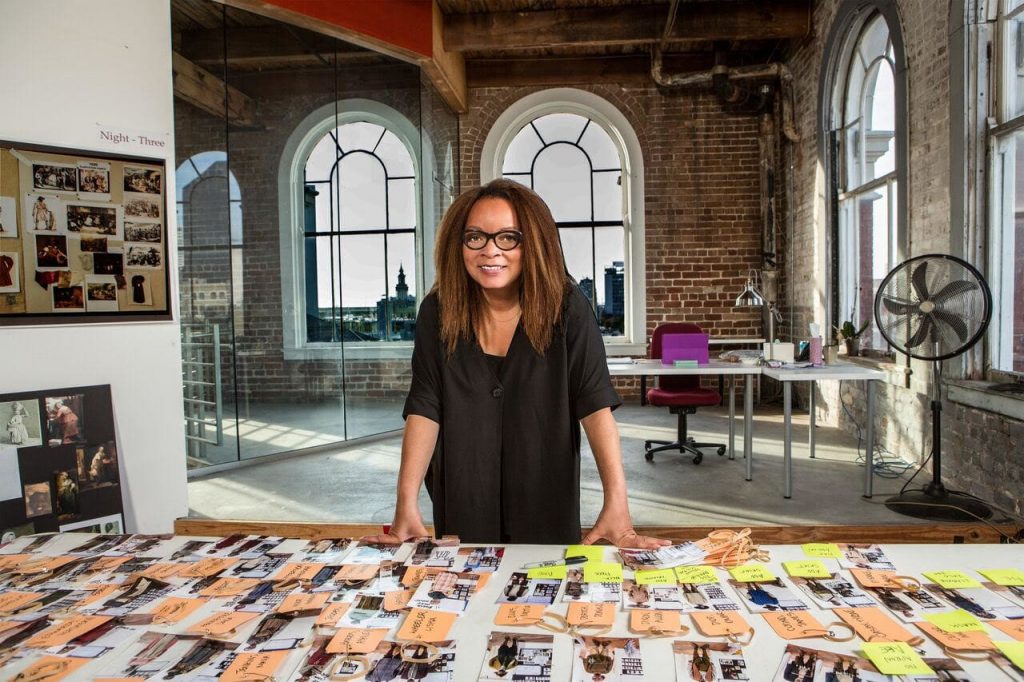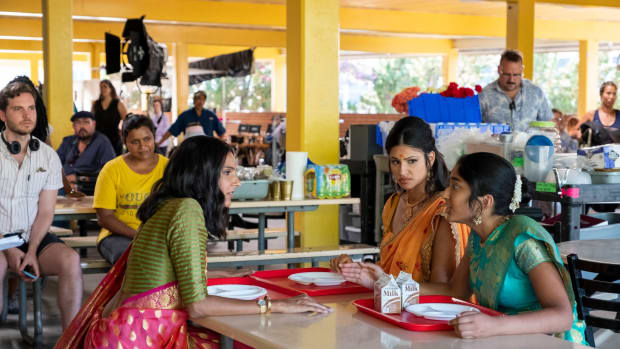
 Like celebrity stylists pivoting toward creative new ways to service their clients and determining alternative income streams during the Covid-19 pandemic, costume designers find themselves in a unique position, too.
Like celebrity stylists pivoting toward creative new ways to service their clients and determining alternative income streams during the Covid-19 pandemic, costume designers find themselves in a unique position, too.
With productions across the country and major studios shut down, their demanding day jobs, which usually stretch into night (or start early mornings), are also on pause. But that doesn’t mean the costume designers themselves are.
“Some people are sitting around watching TV. Not costume designers,” says Salvador Perez, President of the Costume Designers Guild, IATSE Local 892, on a call from sheltering-in-place in Mexico. “We’re not used to down time, so we’re being so efficient with our time.”
Below, Fashionista spoke with television and film designers, as well as their union representatives, to find out how they’ve been staying engaged and inspired.
DIVING INTO OTHER CREATIVE PROJECTS
Perez, who’s custom-designed pieces for Mindy Kaling, both on “The Mindy Project” and the red carpet (plus, a 16-year-old’s debut line on “Never Have I Ever”), is finally starting a “mini-collection” to bring his design style to his fans. “I just want to just test the waters,” he says. “People always say, ‘We want to buy your dresses.’ Well, let’s see if they really do.”
Deirdra Govan (“The Sun is Also a Star,” “Sorry to Bother You”) was in the midst of shooting “Girls Trip” writer Tracy Oliver’s new Amazon series. After initially making masks at home, she decided to apply her Master of Science degree in interior architecture and design, with a focus on sustainability — her “backup plan” — to a dedicated cause. Govan recently joined social impact design agency, Theory of Place Design (formerly Design Angels of America), as a consulting partner, to design and build healthy spaces for homeless youth further displaced by the Covid-19 crisis.
She’s looking forward to returning to set, but “I’m committed either way,” says Govan, on a call, from New York. “[This way, I] can use all the valuable tools in my toolbox. Film is always part of my DNA, but I will carry this responsibility and be held accountable.”
After a busy year finishing “Coming 2 America” and the awards season rounds for “Dolemite is My Name,” Oscar winner Ruth E. Carter had already planned a breather from set. “I had lots of projects that were on my plate; things I had to do on my own,” she says, on a call, from Los Angeles. Quarantining at home — and post-office-cleanout — Spike Lee’s go-to is concentrating on writing her coffee table tome with Chronicle Books, The Art of Ruth E. Carter in Black Cinema. The “Black Panther” designer is also taking meetings, via Zoom, to plan an exhibition tour with design studio MinaLima, “Heroes, the Art and Influence of Ruth E. Carter in Cinema.” Elected to The Academy of Motion Picture Arts and Sciences Board of Governors last year, Carter has also been participating on committees to aid in fighting the Covid-19 crisis.
SUPPORTING THE COMMUNITY, VIRTUALLY
Like the fashion industry venturing into the virtual world, costume design has, too. “I want to inspire and also be sensitive,” says Carter, who made a conscious choice to limiting her own content in recognizing hardships caused by the pandemic. She does, however, enjoy interacting with movie fans, young designers who look up to her and peers through special appearances, like holding a Netflix Watch Party on her birthday, sharing sketches via the Academy of Museum of Motion Pictures #ColoringWithRuthprogram and kicking off Mandi Line‘s colleague-to-colleague interview series on Instagram Live.
The “Pretty Little Liars” designer, who returned to LA after five years in Vancouver designing “Charmed” and “BH90210,” prepared to return to work after a few months off — and then the pandemic hit. Anxious and figuring out her next move, Line caught a screenwriter friend’s IG Live. “I realized, I can do this with costume designers,” she says, over the phone. She quickly became a solo marketing machine, enlisting her “web guy” to create promotional and easily sharable “flyers.” Line then scrappily secured Western Costume Company to sponsor the weekly artwork and taught herself video editing, while “having mini-breakdowns” along the way.
Line also reached out to colleges in her promo efforts. Design student Colin Summers, who needed to complete 90 remaining hours of internship requirements, slid into her DMs and volunteered his help. “I cried,” she says.
Line’s guests so far have included Perez, Meredith Markworth-Pollack (“Dynasty,” “Reign”), Ellen Mirojnick, Eric Daman (giving Tyler a shout-out for that “Gossip Girl” reboot scoop) and Dan Lawson (“The Good Wife”).
“It’s good to keep your name out there for branding and all that,” says Lawson, over the phone, from Nantucket. “But I have to tell you, every time I watch one of her interviews, ‘I’m like, ‘oh my gosh, I just learned something.’ We’re educating the public, as well as, at the same time, other designers — both experienced and not.” Line is constantly upping her IG content, plus planning a podcast. She also sees these efforts as a way to diversify her talents into a hosting gig as another professional option. “It can’t hurt,” says Line. “I can’t sit here and assume I’m going to get a job when it starts up.”
Lawson, who hosted his first Live for fashion brand Lafayette 148, also values the virtual engagement with fellow designers, from all experience levels. He’s been part of SCAD’s Costume Design Friday series, which gives students face-time with experts, including Line, Lou Eyrich, Michelle Cole (“grown-ish,” “#BlackAF”) and Hala Bahmet(“This Is Us”). Free from a hectic shooting schedule, Lawson has also taken on more end-of-year student portfolio reviews, including SUNY Purchase and Brooklyn College, and found himself appreciating the dedicated one-on-one conversations.
“I feel like I have been more connected to other costume designers than I have been in a long time,” he says.
MAKING MASKS
In Hollywood, the West Coast IATSE Mask Initiative banded together unions, including the CDG and costumers local 705, and individual grassroots efforts, including the Masked Crusaders initiative founded by Lauren Oppelt, to make and distribute to hospitals and organizations in need.
Brigitta Romanov, assistant executive director of the CDG and volunteer head of the task force explains that the group quickly created an “assembly line” of operations and opened a drive-through system in the CDG building for drop-offs of donated components and completed product, plus pick-ups of “mask kits,” of 20 each. Non-medical masks are distributed to hospitals and organizations around the country, while UCLA enlisted the group to make 10,000 medical ones out of Halyard H600 surgical material the hospital supplied.
The program plans to wind down by May 29 and Romanov estimates that ultimately the program will have made and distributed upwards of 40,000 masks. “It’s inspiring to know that all these people are giving all this time and effort to help their community,” she says. “It makes me proud to be a union member.”
Designers across the country have made their individual contributions to the efforts, including Govan and Lawson on the East Coast. The latter joined with his “Evil” and “The Good Fight” teams, which have donated PPE and surgical supplies from sets to hospitals and the Callen-Lorde Community Health Center, dedicated to LGBTQ+ care.
Staci Greenbaum (“Awkwafina is Nora From Queens,” “Broad City”) started making non-medical masks in neutral hues, Japanese cottons and Shibori-dyed prints to keep friends and family safe, and ultimately turned it into a business. “After I made 10 masks, I thought, ‘This is something that gives me a lot of validation and purpose,'” she says, over the phone. The project provides Greenbaum with mental health self-care, as well as, some income relief during the shut-down.
WORKING FROM HOME

Cecily Strong as Jeannine Pirro on Weekend Update with Colin Jost on ‘Saturday Night Live at Home’
Screenshot: ‘Saturday Night Live’
With shows creatively flexing with remote and socially-distanced alternatives, some designers continued working and adapting their craft through the crisis.
Live competition show “The Voice” headed into the finale with contestants singing from home. So longtime designer Erin Hirsh and a scaled-down crew helped contestants choose performance-ready looks from their own wardrobes, plus quickly pinpointed online retailers to meet short-timelines. “Those three shopping days in the beginning were exhausting,” Hirsh tells Fashionista via email. “We worked at least 10 hours a day shopping online.” Leading into the finale, the team pulled together “head-to-toe outfits,” from undergarments to jewelry, plus sent steamers, top-stick and fitting supplies and style guides — plus return-to-sender wardrobe boxes — to each contender.
For the final three episodes, “Saturday Night Live” provided much-needed comedic relief with the cast filming and dressing at home. Without access to the show’s vast costume closet, Tom Broecker helped cast members select from their own (and in the case of Mikey Day, his son’s) closets to fit sketch needs. Some, of course, were lower maintenance that others.
“Pete [Davidson] sort of does his thing with his family,” says Broecker, over the phone. “‘OK, what do you guys want to wear? Well, do you have a black hoodie or not have a black hoodie?'”
He also scoured the internet to order and quickly ship pieces across the country. For “What’s Up With That? At Home,” Broecker hunted for a mulberry suit to match Kenan Thompson’s previous ones, plus found identical blue sequin dresses for Ego Nwodim and Melissa Villaseñor on Amazon. Lacking on-site tailoring services, Broecker also instructed cast, via video call, through customizing their own costumes, like sending Chloe Fineman DIY stencils to cut panels into the shoulders of a black dress matching journalist Andrea Kremer’s in the “The Last Dance” Michael Jordan documentary spoof. He also ordered a plethora of yellow bows for Cecily Strong and talked her through constructing a bonkers look with safety pins to play a “PinaClorox”-quaffing Jeanine Pirro on “Weekend Update (above).”
PREPARING TO GO BACK TO WORK
These social distanced costume design efforts above may also serve as experimentation in how production could adjust when filming resumes. With hair and makeup artists, the costume teams are in such close physical contact with the actors — not just for fittings, but also constructive discussions in how to develop a character.
Currently, the CDG, along with fellow IATSE union locals, including 705 (costumers) and 706 (hair and makeup), and The Alliance of Motion Picture and Television Producers (AMPTP), are in deep discussions to determine safety protocols to restart productions. (There’s also Tyler Perry’s quarantine-together set concept in Atlanta.)
“It’s massive hours of meetings with all of the locals, talking about their work, and what we have in common,” explains Perez. “For example, how do we deal with being crammed together in a van to set or how do we handle craft service safely?” Clocking over “30 hours of Zoom calls” thus far, they’re addressing concerns from adding wash stations and a safety department on each set, to specific details, like dry-cleaning, transferring safety pins from fitting room to set and back, and coordinating guidelines with brick-and-mortar retailers, frequented by costume teams. Along with physical safety, mental health is a huge concern. “Because people are going to go back to work with PTSD and they’re going to be afraid of everything,” he says.
“We know this is a multi-step process,” adds Perez, about compiling the comprehensive “document,” covering all productions in the U.S. and Canada, to be sent for approvals from states and cities. Then the studios need to actually implement the changes. “It’s months away.”
